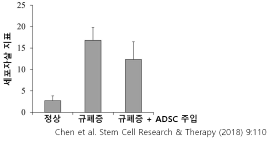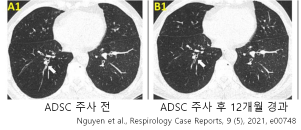07 Treatment of lung disease by ADSC
페이지 정보

본문
1. What types of lung diseases are there?
Diseases that are widely known to the public include pneumonia, pulmonary tuberculosis, and lung cancer, and somewhat unfamiliar diseases include obstructive lung disease and restrictive lung disease. Pneumonia and pulmonary tuberculosis are generally caused by infection with pathogens and can be cured with antibiotics. Lung cancer is caused by complex causes such as smoking, asbestos, polluted air, and genetic factors, and is treated with surgery and chemotherapy.
Obstructive pulmonary disease is when the airways are blocked and breathing problems occur, such as asthma or COPD (Chronic obstructive pulmonary disease). Restrictive lung disease is a condition in which the lungs do not expand sufficiently when inhaling due to decreased extensibility of the lungs, and includes pulmonary fibrosis, pneumoconiosis, and RDS (respiratory distress syndrome). Asthma is a disease that manifests a chronic inflammatory response as a result of an immune response to allergens and is characterized by bronchial narrowing, lung remodeling, and bronchial hyperresponsiveness. Emphysema and chronic bronchitis are representative diseases of COPD. Both are diseases caused by inflammation caused by smoking, dust, etc. When the walls of the alveoli are damaged and the small alveoli are converted into one large alveolus, it becomes emphysema. When the bronchi become inflamed and narrow, it becomes chronic bronchitis. If your bronchi are narrowed or your alveoli are damaged, you may have more difficulty exhaling than inhaling.

RDS is a disease in which surfactant is not secreted into the alveoli and the alveoli do not expand, often occurring in premature babies. Pulmonary fibrosis is a disease in which excessive fibrous connective tissue accumulates in scars caused by autoimmune diseases, viral infections, pulmonary tuberculosis, etc., thickening the walls between alveoli.
Pneumoconiosis is a type of occupational disease in which people working in coal mines or mines inhale a lot of coal dust or silicic acid, causing an inflammatory reaction and resulting in the accumulation of fibrous connective tissue.

2. What functions of ADSCs can help treat lung disease?
As mentioned in the previous video, ADSCs have the following abilities: promoting angiogenesis, secreting growth factors, suppressing inflammatory responses, preventing apoptosis, and differentiating into other cells. Injecting ADSC into asthmatic mice improves asthma symptoms because of the inhibitory effect of ADSC on the inflammatory response (Castro et al., STEM CELLS Transl Med. 2019;1–11).
Castro et al. showed that in asthmatic mice injected with ADSCs, levels of airway inflammation, white blood cells in the bronchi and alveoli, and levels of the

inflammatory substance TGF-β were all significantly reduced compared to asthmatic mice injected with saline solution.
ADSC's ability to suppress inflammatory responses and prevent apoptosis improved the symptoms of mice suffering from silicosis, a type of pneumoconiosis (Chen et al. Stem Cell Research & Therapy (2018) 9:110).

In mice with silicosis, the shape of the alveoli is greatly destroyed compared to normal lungs, and many immune cells have infiltrated into the lung tissue (arrows). On the other hand, when ADSCs were injected into mice with silicosis, the alveolar tissue was similar to normal lungs, and the infiltration of immune cells was minimal.
Additional findings by Chen et al. demonstrate that ADSCs prevent apoptosis in alveolar cells.
The results of silicosis mice show that ADSCs suppressed the infiltration of immune cells due to their immunosuppressive effect, and that the prevention of alveolar damage contributed to the prevention of apoptosis.
In addition to these functions, ADSC exhibits a homing effect. ADSCs injected

intravenously go to the patient's uncomfortable or diseased areas and treat them, but when actually investigated, ADSCs injected intravenously travel to the lungs, liver, and brain, accumulate the most, and then disappear. In other words, given that the lungs are the organ that benefits the most from the homing effect, it appears that the therapeutic effect of ADSC can be maximized. This fact can be seen through an experiment conducted by Baer et al. (Baer et al., Cells 2020, 9, 1444; doi:10.3390).
Baer et al. injected fluorescent ADSCs intravenously into mice showing ataxia-telangiectasia and wild-type mice, which causes lung damage, and then examined the duration of ADSC residence in the lungs using fluorescence.
In the lungs of wild-type mice, ADSCs stayed for up to 3 days, but in the lungs of mice with ataxia telangiectasia, ADSCs stayed for more than 9 days. Baer et al.'s experimental results clearly demonstrate that ADSCs exhibit a homing effect in damaged lungs.
3. What lung diseases does ADSC help treat?
According to the results of animal testing, it appears to be effective in treating silicosis, asthma, and emphysema, and clinical results show that it is effective in treating lung damage and COPD caused by COVID-19. Let’s take a brief look at the effectiveness of ADSC in the treatment of COPD. Nguyen et al. intravenously injected ADSCs extracted from his own fat into a 57-year-old male COPD patient and observed improvement in symptoms for 12 months (Nguyen et al., Respirology Case Reports, 9 (5), 2021, e00748 ).
Comparison of CT pictures of the lungs taken before and 12 months after the ADSC injection is as follows.
White arrows indicate the bronchial tubes, and CT results after ADSC injection show thinner bronchial walls and wider bronchial lumen compared to before ADSC injection. From these results, it can be inferred that this patient's breathing became

smoother after ADSC injection. In fact, this patient showed improvement in symptoms in various areas, with the 6-minute walking distance increasing from 441 meters to 546 meters, with the lower the better. George’s Respiratory Questionnaire (SGRQ) score decreased from 45.95 to 26.03. From the above results, it can be seen that intravenous injection of ADSC is effective in treating COPD. In the future, we hope that treatment using ADSC will be effective in patients with other lung diseases as well.
Diseases that are widely known to the public include pneumonia, pulmonary tuberculosis, and lung cancer, and somewhat unfamiliar diseases include obstructive lung disease and restrictive lung disease. Pneumonia and pulmonary tuberculosis are generally caused by infection with pathogens and can be cured with antibiotics. Lung cancer is caused by complex causes such as smoking, asbestos, polluted air, and genetic factors, and is treated with surgery and chemotherapy.
Obstructive pulmonary disease is when the airways are blocked and breathing problems occur, such as asthma or COPD (Chronic obstructive pulmonary disease). Restrictive lung disease is a condition in which the lungs do not expand sufficiently when inhaling due to decreased extensibility of the lungs, and includes pulmonary fibrosis, pneumoconiosis, and RDS (respiratory distress syndrome). Asthma is a disease that manifests a chronic inflammatory response as a result of an immune response to allergens and is characterized by bronchial narrowing, lung remodeling, and bronchial hyperresponsiveness. Emphysema and chronic bronchitis are representative diseases of COPD. Both are diseases caused by inflammation caused by smoking, dust, etc. When the walls of the alveoli are damaged and the small alveoli are converted into one large alveolus, it becomes emphysema. When the bronchi become inflamed and narrow, it becomes chronic bronchitis. If your bronchi are narrowed or your alveoli are damaged, you may have more difficulty exhaling than inhaling.

RDS is a disease in which surfactant is not secreted into the alveoli and the alveoli do not expand, often occurring in premature babies. Pulmonary fibrosis is a disease in which excessive fibrous connective tissue accumulates in scars caused by autoimmune diseases, viral infections, pulmonary tuberculosis, etc., thickening the walls between alveoli.
Pneumoconiosis is a type of occupational disease in which people working in coal mines or mines inhale a lot of coal dust or silicic acid, causing an inflammatory reaction and resulting in the accumulation of fibrous connective tissue.

2. What functions of ADSCs can help treat lung disease?
As mentioned in the previous video, ADSCs have the following abilities: promoting angiogenesis, secreting growth factors, suppressing inflammatory responses, preventing apoptosis, and differentiating into other cells. Injecting ADSC into asthmatic mice improves asthma symptoms because of the inhibitory effect of ADSC on the inflammatory response (Castro et al., STEM CELLS Transl Med. 2019;1–11).
Castro et al. showed that in asthmatic mice injected with ADSCs, levels of airway inflammation, white blood cells in the bronchi and alveoli, and levels of the

inflammatory substance TGF-β were all significantly reduced compared to asthmatic mice injected with saline solution.
ADSC's ability to suppress inflammatory responses and prevent apoptosis improved the symptoms of mice suffering from silicosis, a type of pneumoconiosis (Chen et al. Stem Cell Research & Therapy (2018) 9:110).

In mice with silicosis, the shape of the alveoli is greatly destroyed compared to normal lungs, and many immune cells have infiltrated into the lung tissue (arrows). On the other hand, when ADSCs were injected into mice with silicosis, the alveolar tissue was similar to normal lungs, and the infiltration of immune cells was minimal.
Additional findings by Chen et al. demonstrate that ADSCs prevent apoptosis in alveolar cells.
The results of silicosis mice show that ADSCs suppressed the infiltration of immune cells due to their immunosuppressive effect, and that the prevention of alveolar damage contributed to the prevention of apoptosis.
In addition to these functions, ADSC exhibits a homing effect. ADSCs injected

intravenously go to the patient's uncomfortable or diseased areas and treat them, but when actually investigated, ADSCs injected intravenously travel to the lungs, liver, and brain, accumulate the most, and then disappear. In other words, given that the lungs are the organ that benefits the most from the homing effect, it appears that the therapeutic effect of ADSC can be maximized. This fact can be seen through an experiment conducted by Baer et al. (Baer et al., Cells 2020, 9, 1444; doi:10.3390).
Baer et al. injected fluorescent ADSCs intravenously into mice showing ataxia-telangiectasia and wild-type mice, which causes lung damage, and then examined the duration of ADSC residence in the lungs using fluorescence.
In the lungs of wild-type mice, ADSCs stayed for up to 3 days, but in the lungs of mice with ataxia telangiectasia, ADSCs stayed for more than 9 days. Baer et al.'s experimental results clearly demonstrate that ADSCs exhibit a homing effect in damaged lungs.
3. What lung diseases does ADSC help treat?
According to the results of animal testing, it appears to be effective in treating silicosis, asthma, and emphysema, and clinical results show that it is effective in treating lung damage and COPD caused by COVID-19. Let’s take a brief look at the effectiveness of ADSC in the treatment of COPD. Nguyen et al. intravenously injected ADSCs extracted from his own fat into a 57-year-old male COPD patient and observed improvement in symptoms for 12 months (Nguyen et al., Respirology Case Reports, 9 (5), 2021, e00748 ).
Comparison of CT pictures of the lungs taken before and 12 months after the ADSC injection is as follows.
White arrows indicate the bronchial tubes, and CT results after ADSC injection show thinner bronchial walls and wider bronchial lumen compared to before ADSC injection. From these results, it can be inferred that this patient's breathing became

smoother after ADSC injection. In fact, this patient showed improvement in symptoms in various areas, with the 6-minute walking distance increasing from 441 meters to 546 meters, with the lower the better. George’s Respiratory Questionnaire (SGRQ) score decreased from 45.95 to 26.03. From the above results, it can be seen that intravenous injection of ADSC is effective in treating COPD. In the future, we hope that treatment using ADSC will be effective in patients with other lung diseases as well.
- Prevwhat is an exosome? 24.04.16
- NextArthritis treatment using adipose stem cells 24.04.16
댓글목록
등록된 댓글이 없습니다.






 +82-2-532-2856
+82-2-532-2856 info@panacellbio.com
info@panacellbio.com 521, Teheran-ro, Gangnam-gu, Seoul, Republic of Korea
521, Teheran-ro, Gangnam-gu, Seoul, Republic of Korea